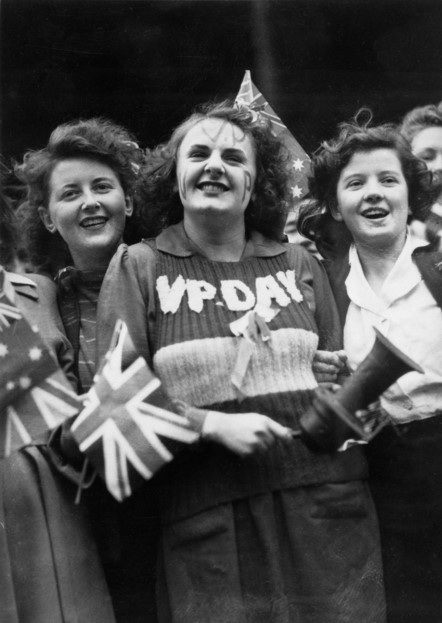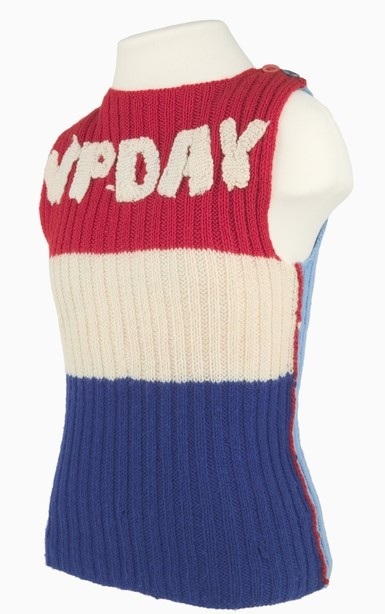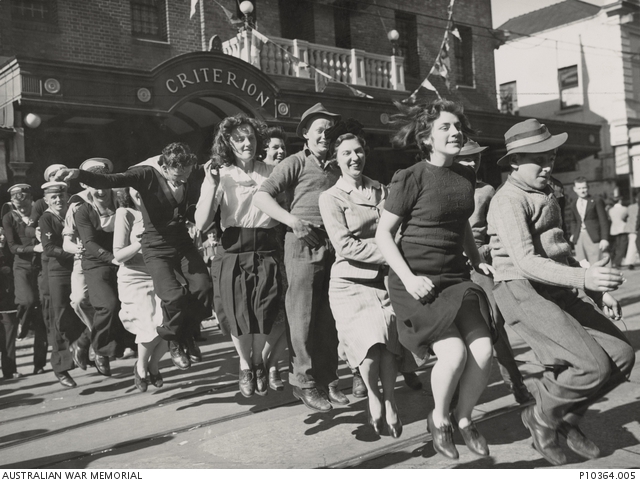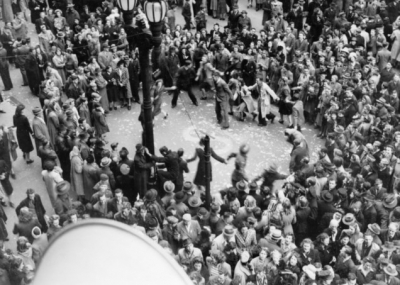In August 1995 Melbourne’s Herald Sun printed the below photo to accompany an article which asked its readers, ‘Were you the VP Day girl, or one of the girls flanking her as she celebrated the end of the war in the Pacific? If so, then then the Herald Sun would like to hear from you’.

It was no coincidence that the Herald Sun was seeking the identity of the woman in this photograph. 1995 marked the 50th anniversary of the end of the Second World War, and the Australian War Memorial was opening a new exhibition which featured this captivating image.
It wasn’t long before the ‘mystery sweater girl’ was identified. Bill Drew came forward and said it was a picture of his late wife, Lois Anne Drew (nee Martin). As proof, he produced the hand knitted vest that she had made and worn 50 years prior on Victory in the Pacific (VP) Day, the 15th August, 1945. A successful end to the search – Lois graced the front cover of the Herald Sun on Monday 14th August 1995 in a special VP edition.
Before they were married, Miss Lois Martin grew up in Richmond, Victoria. During the Second World War she worked at the Kodak Factory in Abbotsford. The two women either side of her were also identified, as work mates from the Kodak factory; on the left was Betty Williams and Carmel O’Connor on the right. Lois’ experience was like that of many other women who took up work a factory to support the war effort.
On 8 May, 1945, German High Command surrendered, and the war in Europe was over. In Australia, celebrations for Victory in Europe Day or VE Day were overshadowed by the war to the North. Australian soldiers were still fighting and dying in the Pacific, and Australian prisoners were still held captive. In light of this, Australians were encouraged to attend a thanksgiving service in their city or church on VE Day. On the 9th of May, a huge crowd of 100,000 gathered at the Shrine of Remembrance for a commemorative service.

With Germany defeated, many Australians then anticipated the end of the war with Japan. Lois certainly did when she took up her knitting needles and made this this colourful vest. We don’t know exactly how long it took her to knit, but something as simple as this vest could be made by an experienced knitter in a matter of weeks. Commercial knitting patterns with a victory theme were produced throughout the war. Lois may have adapted a civilian vest pattern and changed the colours as she worked up the front piece.

Victory was in sight. American bombers devastated the Japanese cities of Hiroshima and Nagasaki. A week later, the Japanese surrendered. News of the surrender reached Australia via the radio on the morning of the 15th August 1945 at 9.30am in a live broadcast. Prime Minister Ben Chifley announced,
Fellow Citizens, the war is over. The Japanese Government has accepted the terms of surrender imposed by the Allied Nations and hostilities will now cease… At this moment, let us offer thanks to God. Let us remember those whose lives were given that we may enjoy this glorious moment and may look forward to a peace which they have won for us.
In contrast to the sombre air of VE Day, the celebrations on VP Day were joyous and chaotic. In major cities and towns across Australia thousands of people flocked to the streets to dance and sing. The day was declared a public holiday and celebrations continued into the evening – shops were closed, but theatres, dance halls and pubs remained open.

For many in Australia the end of the war in the Pacific was marked by celebration, but for others it was a day of sombre commemoration and relief. For those who had lost loved ones, the cost was high- almost 40,000 Australians had been killed.
After the celebrations, Lois Martin put her VP Day vest away and never wore it again. She kept it all of her life, and her husband kept it for 14 years after her death until he donated to the Australian War Memorial. This highly significant national icon is currently on display in their Second World War gallery.
By Eleni Holloway, Assistant Curator, Military Heraldry & Technology AWM.

